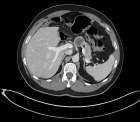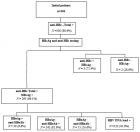Abstract
Research Article
Conservative treatment versus invasive approach in elderly patients with myocardial infarction without ST-segment elevation
Alexandra Cozma*, Adriana Ardelean, Katalin Babes and Mircea Ioachim Popescu
Published: 30 April, 2020 | Volume 5 - Issue 1 | Pages: 101-104
Myocardial infarction without ST segment elevation is one of the most common causes of hospitalization of the elderly patient [1]. Coronarography followed by revascularization, is performed in the vast majority of cases of myocardial infarction without ST segment elevation, in the regions with a well-developed health system. The decision to perform the procedure, the type of approach (early/late) and the selection of the type of myocardial revascularization depend on numerous factors such as: associated comorbidities, clinical presentation, the risk group in which the patient is framed, fragility, cognitive status, life expectancy etc. [2,3]. Older patients often present with various comorbidities, having a higher risk of complications and an unfavorable evolution. Thus, it was observed that invasively treatment is less commonly used in elderly patients with comorbidities, even if, the current guideline recommends that the invasive strategy should be considered in all patients with NSTEMI, regardless of age. At the same time, this subgroup of patients is not so well represented in the studies performed so far, the type of treatment chosen, being most often at the discretion of the attending physician [1,2].
Objective The present study aims to analyze the evolution of a subgroup of patients ≥ 70 years of age, with different comorbidities, with the diagnosis of myocardial infarction without ST segment elevation, according to the type of treatment applied: conservative versus invasive strategy (diagnostic coronarography ± revascularization, if appropriate).
Read Full Article HTML DOI: 10.29328/journal.jccm.1001094 Cite this Article Read Full Article PDF
Keywords:
Elderly; Non ST myocardial infarction; Treatment; Comorbidities; Mortality
References
- Tegn N, Abdelnoor M, Aaberge L, Endresen K, Smith P, et al. Invasive versus conservative strategy in patients aged 80 years or older with non-ST-elevation myocardial infarction or unstable angina pectoris (After Eighty study): an open-label randomised controlled trial. Lancet. 2016; 387: 1057-1065. PubMed: https://www.ncbi.nlm.nih.gov/pubmed/26794722
- Roffi M, Patrono C, Collet JP, Mueller C, Valgimigli M, et al. 2015 ESC Guidelines for the management of acute coronary syndromes in patients presenting without persistent ST-segment elevation: Task Force for the Management of Acute Coronary Syndromes in Patients Presenting without Persistent ST-Segment Elevation of the European Society of Cardiology (ESC). Eur Heart J. 2016; 37: 267–315. PubMed: https://www.ncbi.nlm.nih.gov/pubmed/26320110
- Sanchis J, Ariza-Solé A, Abu-Assi E, Alegre O, Alfonso F, et al. Invasive Versus Conservative Strategy in Frail Patients With NSTEMI: The MOSCA-FRAIL Clinical Trial Study Design”, Revista Espanola de Cardiologia. 2019; 72: 154-159. PubMed: https://www.ncbi.nlm.nih.gov/pubmed/29525724
- Stefano S, Nuccia M, Stefano DS, Treatment of Acute Coronary Syndromes in the Elderly and in Patients With Comorbidities. Revista Espanola de Cardiologia. 2014; 67: 564-573.
- Negers A, Boddaert J, Mora L, Golmard JL, Moïsi L, et.al. Determinants of invasive strategy in elderly patients with non-ST elevation myocardial infarction”,Journal of Geriatric Cardiology. 2017; 14: 465–472. PubMed: https://www.ncbi.nlm.nih.gov/pmc/articles/PMC5545189/
- Savonitto S, Cavallini C, Petronio AS, Murena E, Antonicelli R, et al. Early Aggressive Versus Initially Conservative Treatment in Elderly Patients With Non–ST-Segment Elevation Acute Coronary Syndrome: A Randomized Controlled Trial. JACC: Cardiovascular Interventions. 2012; 5: 906-916, PubMed: https://www.ncbi.nlm.nih.gov/pubmed/22995877
- Cheng-Chun Wei, Shih-Huang Lee, Predictors of Mortality in Elderly Patients with Non-ST Elevation Acute Coronary Syndrome - Data from Taiwan Acute Coronary Syndrome Full Spectrum Registry”. Acta Cardiologica Sinica. 2017; 33: 377-383. PubMed: https://www.ncbi.nlm.nih.gov/pubmed/29033508
Similar Articles
-
Left Atrial Remodeling is Associated with Left Ventricular Remodeling in Patients with Reperfused Acute Myocardial InfarctionChristodoulos E. Papadopoulos*,Dimitrios G. Zioutas,Panagiotis Charalambidis,Aristi Boulbou,Konstantinos Triantafyllou,Konstantinos Baltoumas,Haralambos I. Karvounis,Vassilios Vassilikos. Left Atrial Remodeling is Associated with Left Ventricular Remodeling in Patients with Reperfused Acute Myocardial Infarction. . 2016 doi: 10.29328/journal.jccm.1001001; 1: 001-008
-
Indications and Results of Coronarography in Senegalese Diabetic Patients: About 45 CasesNdao SCT*,Gaye ND,Dioum M,Ngaide AA,Mingou JS,Ndiaye MB, Diao M,Ba SA. Indications and Results of Coronarography in Senegalese Diabetic Patients: About 45 Cases. . 2017 doi: 10.29328/journal.jccm.1001007; 2: 013-019
-
Procedure utilization, latency and mortality: Weekend versus Weekday admission for Myocardial InfarctionNader Makki,David M Kline,Arun Kanmanthareddy,Hansie Mathelier,Satya Shreenivas,Scott M Lilly*. Procedure utilization, latency and mortality: Weekend versus Weekday admission for Myocardial Infarction. . 2017 doi: 10.29328/journal.jccm.1001008; 2: 020-025
-
Thrombolysis, the only Optimally Rapid Reperfusion TreatmentVictor Gurewich*. Thrombolysis, the only Optimally Rapid Reperfusion Treatment. . 2017 doi: 10.29328/journal.jccm.1001010; 2: 029-034
-
Incidence of symptom-driven Coronary Angiographic procedures post-drug-eluting Balloon treatment of Coronary Artery drug-eluting stent in-stent Restenosis-does it matter?Victor Voon*,Dikshaini Gumani,Calvin Craig,Ciara Cahill,Khalid Mustafa,Terry Hennessy,Samer Arnous,Thomas Kiernan. Incidence of symptom-driven Coronary Angiographic procedures post-drug-eluting Balloon treatment of Coronary Artery drug-eluting stent in-stent Restenosis-does it matter?. . 2017 doi: 10.29328/journal.jccm.1001011; 2: 035-041
-
Subacute infectious endocarditis-associated membranoproliferative glomerular nephritis: A Case Report and ReviewYi De Zhang,Ya Min Yu,Hou Yong Dai,Xiao Lan Chen,Li Yuan,Hui Shi*. Subacute infectious endocarditis-associated membranoproliferative glomerular nephritis: A Case Report and Review. . 2017 doi: 10.29328/journal.jccm.1001014; 2: 052-055
-
A new heart: portraying the physiologic anatomo-functional reconstruction in ischemic cardiomyopathyMarco Cirillo*,Marco Campana,Anna Bressanelli,Giovanni Troise. A new heart: portraying the physiologic anatomo-functional reconstruction in ischemic cardiomyopathy. . 2017 doi: 10.29328/journal.jccm.1001016; 2: 063-067
-
Non-hemodynamic factors associated to the risk of developing hypertensive cardiopathyAlexis Álvarez-Aliaga*,Julio César González-Aguilera,Liliana del Rosario Maceo-Gómez,Lic David del Llano Sosa,Raúl Leyva-Castro,Rosa Ojeda-Vázquez. Non-hemodynamic factors associated to the risk of developing hypertensive cardiopathy. . 2017 doi: 10.29328/journal.jccm.1001017; 2: 068-084
-
Design and validation of an Index to predict the development of Hypertensive CardiopathyAlexis Álvarez-Aliaga*,Andrés José Quesada-Vázquez,Alexis Suárez-Quesada,David de Llano Sosa. Design and validation of an Index to predict the development of Hypertensive Cardiopathy. . 2018 doi: 10.29328/journal.jccm.1001022; 3: 008-022
-
Cardiovascular damage during lupus in black African subjectsYaméogo NV*,Tougouma SJ-B,Zabsonré J,Kologo KJ,Tiemtoré WS,Kagambèga LJ,Bagbila WPAH, Traoré A,Samadoulougou AK,Zabsonré P. Cardiovascular damage during lupus in black African subjects. . 2018 doi: 10.29328/journal.jccm.1001024; 3: 031-034
Recently Viewed
-
Flood Risk Management in South-west Nigeria: Lagos as a Case StudyIdowu Michael*. Flood Risk Management in South-west Nigeria: Lagos as a Case Study. Ann Civil Environ Eng. 2024: doi: 10.29328/journal.acee.1001073; 8: 096-097
-
Association Between Electrocardiographic Abnormalities and In-Hospital Adverse Outcome in COVID-19 PatientsAnjuman Begum*, Wadud Chowdhury, Suman KS, Arnab KC, Md. Akteruzzaman, Barua Sushanta. Association Between Electrocardiographic Abnormalities and In-Hospital Adverse Outcome in COVID-19 Patients. J Cardiol Cardiovasc Med. 2024: doi: 10.29328/journal.jccm.1001196; 9: 148-152
-
Gentian Violet Modulates Cytokines Levels in Mice Spleen toward an Anti-inflammatory ProfileSalam Jbeili, Mohamad Rima, Abdul Rahman Annous, Abdo Ibrahim Berro, Ziad Fajloun, Marc Karam*. Gentian Violet Modulates Cytokines Levels in Mice Spleen toward an Anti-inflammatory Profile. Arch Asthma Allergy Immunol. 2024: doi: 10.29328/journal.aaai.1001034; 8: 001-006
-
Premaxillary osteotomy in children with bilateral cleft lip and palate: Skeletal and dental changesMireia Aznar Gomez*,Lluisa Tobella Camps,Alejandro Rivera Baró. Premaxillary osteotomy in children with bilateral cleft lip and palate: Skeletal and dental changes. J Oral Health Craniofac Sci. 2020: doi: 10.29328/journal.johcs.1001032; 5: 011-016
-
Therapeutic Implications of Stem Cell SecretomeHo Jia Huey, Clayton Chu Jia Teng, Marek Kukumberg, Abdul Jalil Rufaihah*. Therapeutic Implications of Stem Cell Secretome. J Stem Cell Ther Transplant. 2024: doi: 10.29328/journal.jsctt.1001039; 8: 029-032
Most Viewed
-
Evaluation of Biostimulants Based on Recovered Protein Hydrolysates from Animal By-products as Plant Growth EnhancersH Pérez-Aguilar*, M Lacruz-Asaro, F Arán-Ais. Evaluation of Biostimulants Based on Recovered Protein Hydrolysates from Animal By-products as Plant Growth Enhancers. J Plant Sci Phytopathol. 2023 doi: 10.29328/journal.jpsp.1001104; 7: 042-047
-
Feasibility study of magnetic sensing for detecting single-neuron action potentialsDenis Tonini,Kai Wu,Renata Saha,Jian-Ping Wang*. Feasibility study of magnetic sensing for detecting single-neuron action potentials. Ann Biomed Sci Eng. 2022 doi: 10.29328/journal.abse.1001018; 6: 019-029
-
Sinonasal Myxoma Extending into the Orbit in a 4-Year Old: A Case PresentationJulian A Purrinos*, Ramzi Younis. Sinonasal Myxoma Extending into the Orbit in a 4-Year Old: A Case Presentation. Arch Case Rep. 2024 doi: 10.29328/journal.acr.1001099; 8: 075-077
-
Pediatric Dysgerminoma: Unveiling a Rare Ovarian TumorFaten Limaiem*, Khalil Saffar, Ahmed Halouani. Pediatric Dysgerminoma: Unveiling a Rare Ovarian Tumor. Arch Case Rep. 2024 doi: 10.29328/journal.acr.1001087; 8: 010-013
-
Physical activity can change the physiological and psychological circumstances during COVID-19 pandemic: A narrative reviewKhashayar Maroufi*. Physical activity can change the physiological and psychological circumstances during COVID-19 pandemic: A narrative review. J Sports Med Ther. 2021 doi: 10.29328/journal.jsmt.1001051; 6: 001-007

HSPI: We're glad you're here. Please click "create a new Query" if you are a new visitor to our website and need further information from us.
If you are already a member of our network and need to keep track of any developments regarding a question you have already submitted, click "take me to my Query."























































































































































